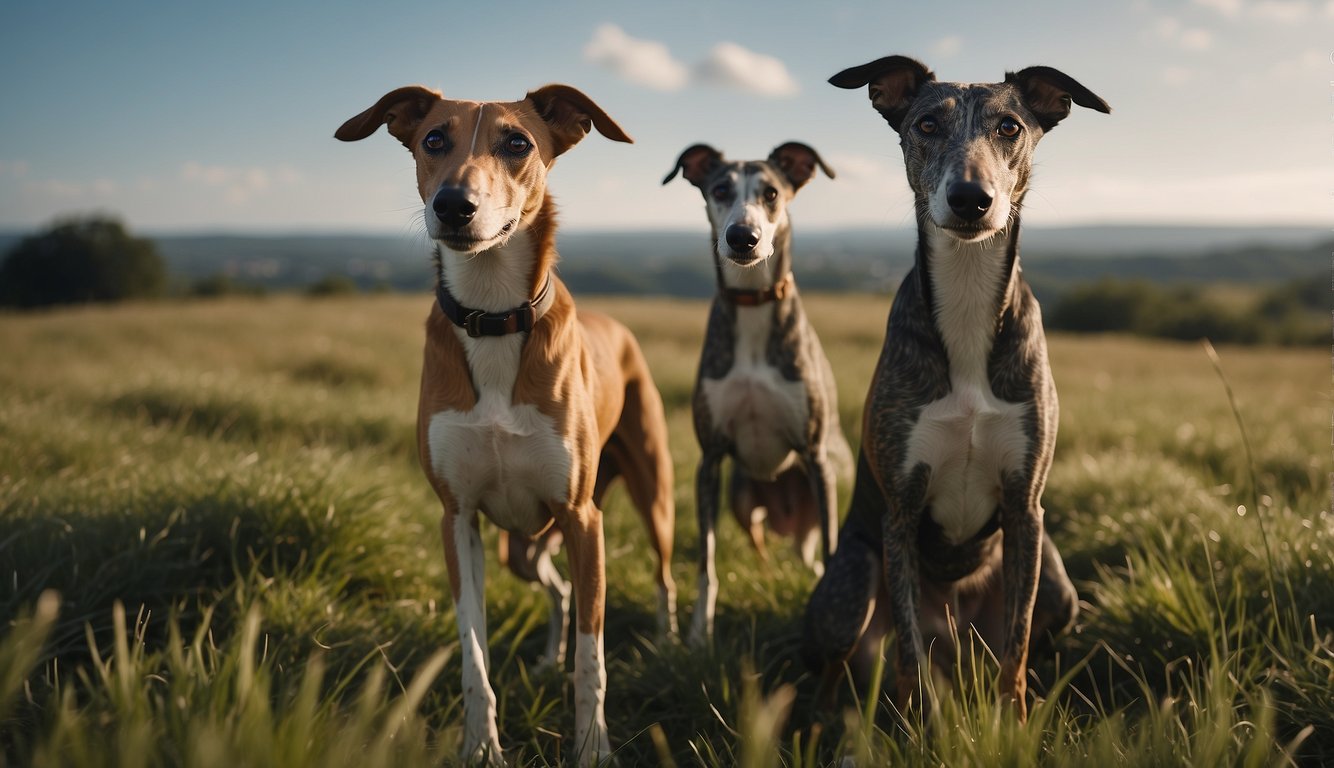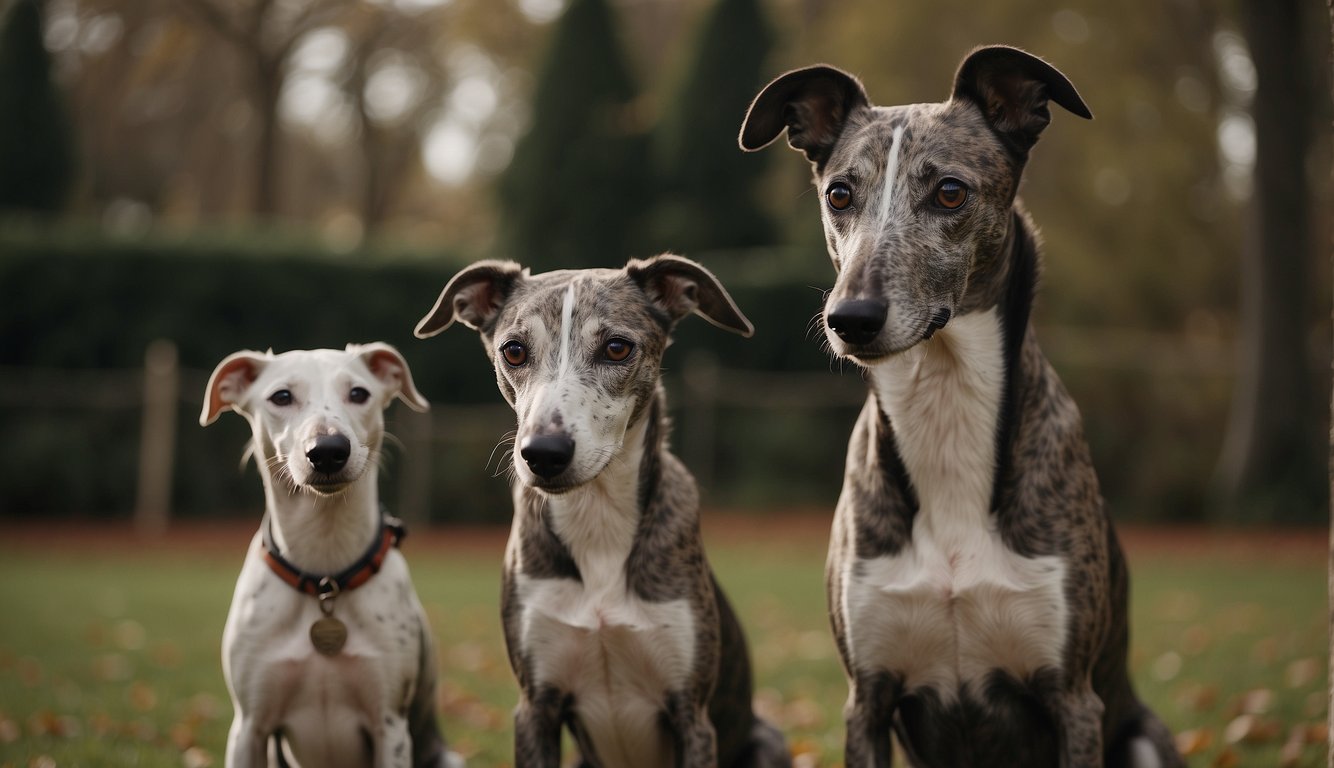When considering adding a greyhound to your family, you might wonder about their communication style and if they’re prone to barking. Generally characterized as a quiet breed, greyhounds are not famed for their barking. Instead, they communicate their needs and feelings in a more reserved manner. Their barking tends to be situational rather than constant, reacting to specific incidents like a new person at the door or during playtime, displaying their contentment.

Greyhounds exhibit a unique vocal behavior that differentiates them from other breeds. They may not bark excessively, but some do express themselves through a distinctive sound known as a “roo,” which is more akin to a howl or yodel. This form of communication is particularly common when they are excited or engaging with other greyhounds. Understanding their vocal habits helps in nurturing a positive living environment and creates a stronger bond between you and your pet.
Key Takeaways
- Greyhounds are a quiet breed that typically don’t bark much.
- Barking in greyhounds is usually situational and indicates happiness or alerts to something new.
- Their unique “roo” vocalization can signify excitement and offers insight into greyhound behavior.
Understanding Greyhound Behavior

When you’re trying to understand your greyhound’s behavior, it’s important to consider their communication methods, what influences their barking, and the traits that are specific to their breed.
Communication and Vocalization
Greyhounds communicate in various ways, not just through barking. They may use body language, such as ear positioning and tail wagging, to express their emotions. You might notice a growl when they’re uneasy or a playful ‘roo’ or howling when they’re excited. This breed’s vocalizations are often a response to their environment, exercise, or anxiety.
Factors Influencing Barking
Barking in greyhounds can be influenced by several factors:
- Emotions: Feelings of excitement or pain can prompt barking.
- Exercise: Lack of proper exercise might lead to excess energy, resulting in more vocalization.
- Anxiety: Situations causing separation anxiety may cause your greyhound to bark more.
- Environment: A noisy environment might trigger a barking response.
- Temperament: Some greyhounds, due to individual personality, may bark more than others.
Prey drive is another consideration, as greyhounds are sighthounds with a strong instinct to chase, which can lead to barking.
Breed-Specific Traits
Greyhounds are generally known for being a quiet dog breed. Their temperament typically leans towards calmness and gentleness, not predisposed to unnecessary barking. However, every dog is an individual, and while genetic predisposition plays a role—where greyhounds are bred to be silent hunters—individual personality can also influence barking frequency.
Greyhound Care and Training

When it comes to raising a Greyhound, it’s essential to focus on exercise, training techniques, and health maintenance to ensure your dog is happy, healthy, and well-behaved.
Exercise and Stimulation
Your Greyhound is an athletic dog with roots as a sighthound, which means they love to chase. Daily exercise is crucial and should include a combination of walks and opportunities to run in a safe, enclosed space. Playtime is not only fun but also stimulates their mind, preventing boredom.
- Daily Walks: Aim for at least 30-60 minutes of walking each day.
- Chase and Play: Engage them in activities that mimic their natural chasing instincts.
Training Techniques
Greyhounds are known for their sweet and patient nature, making them relatively easy to train, but be aware they can have a stubborn streak. Use positive reinforcement methods, as Greyhounds respond well to treats and praise.
- Positive Reinforcement: Offer rewards for good behavior.
- Consistency: Regular training sessions help reinforce commands.
- Patience: Be patient as Greyhounds may not respond immediately.
Health and Maintenance
Your Greyhound’s health and maintenance revolve around a proper diet, regular grooming, and health checks. Maintain their weight within the recommended range to prevent obesity.
- Diet: A balanced diet rich in protein is vital.
- Grooming: They are a low-maintenance dog in terms of grooming, requiring only occasional brushing.
- Teeth and Nails: Regular dental care and nail trimming are part of a good health routine.
address specific aspects like weight, size, and maintenance:
- Weight: Males generally weigh 65 to 85 pounds, and females range from 50 to 65 pounds.
- Size: Height ranges from 25 to 30 inches, depending on their role (racing or show).
- Maintenance: Simple routines are enough to keep them in top shape.
Making Greyhounds Part of Your Family

When you adopt a Greyhound, you’re bringing home a pet known for its gentle nature and adaptability. Creating a welcoming environment and fostering socialization are pivotal to integrate your new Greyhound into the family fold.
Adoption and Adaptation
Upon adopting a Greyhound, understanding its past is crucial. If your new companion is a retired racer, it’s likely already trained, which simplifies its adaptation process. Greyhounds, revered for their intelligence and eagerness to please, typically adapt well to family life. Here’s what you need to consider:
- Environment: Prepare a comfortable and safe space. Apartments are suitable as long as you provide regular exercise.
- Socialization: Introduce your Greyhound to various environments and people to foster adaptability.
Integrating with Children and Other Pets
Greyhounds are sweet and gentle breeds, making them fitting pets for families with children. However, every pet has a unique personality, so keep an eye on the dynamics between your Greyhound and kids to ensure a smooth integration. Here are some pointers:
- With Children: Teach your children how to interact with dogs gently. Greyhounds can be great playmates when treated with respect.
- With Other Pets: Monitor interactions closely at first, especially if you have smaller pets. Greyhounds typically get along with other dogs, but early socialization is key to ease potential tensions.
Frequently Asked Questions

In this section, you’ll find specific information regarding common inquiries about the barking behaviors of greyhounds, to help you understand what to expect from this breed.
Are greyhounds considered excessive barkers?
Greyhounds are not typically excessive barkers. They bark less frequently than many other dog breeds, making them a relatively quiet choice for a pet.
Do greyhounds tend to bark more during nighttime?
No, greyhounds do not generally bark more at night. They have a calm temperament and tend to keep quiet unless there is a specific reason to bark.
How likely are greyhounds to bark at strangers or potential intruders?
Greyhounds might bark at strangers, but it is more out of curiosity or excitement than as a warning or defensive behavior. They are not considered good watchdogs due to their friendly nature.
Can greyhounds be classified as quiet when compared to other dog breeds?
Yes, greyhounds can be classified as quiet compared to other breeds. They tend to be less vocal and may not bark unless there’s a particular reason.
What are common reasons that might cause a greyhound to bark?
Common reasons for a greyhound to bark include excitement, such as greeting their owner, or to alert you to someone’s presence. They may also vocalize during play.
Is barking behavior prominent in greyhounds when they are not engaged or exercised enough?
Lack of exercise or engagement can lead to increased vocalization in any dog breed; however, greyhounds are generally calm and do not typically resort to barking due to boredom or excess energy.

